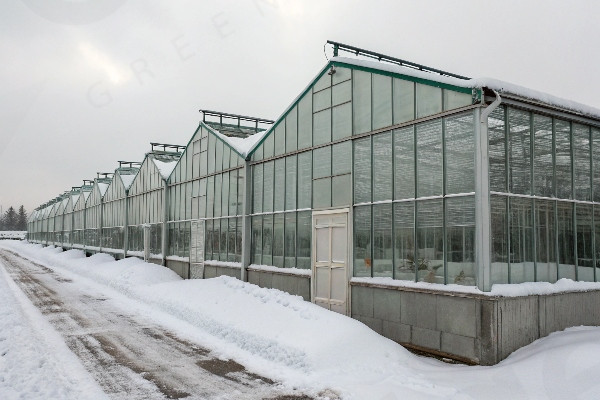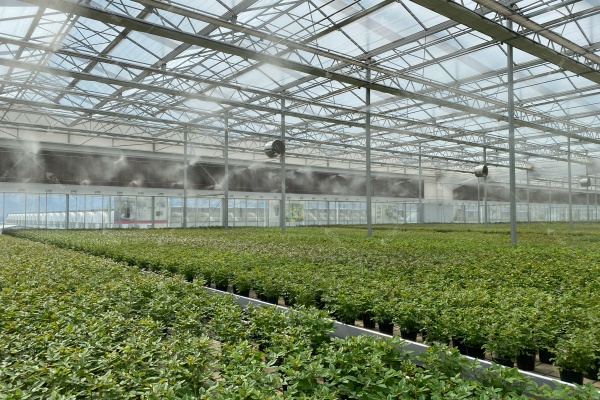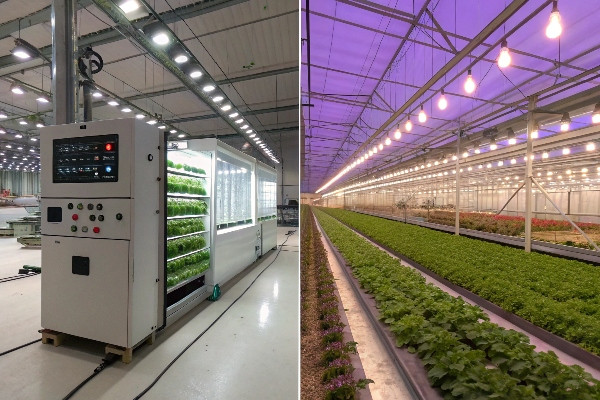Winter brings challenges that can destroy your entire crop investment. Cold temperatures threaten plant survival. Your greenhouse heating strategy determines success or failure.
Effective greenhouse heating combines proper insulation systems, appropriate heating solutions, and smart climate control. The right approach reduces energy costs by 40-60% while maintaining optimal growing conditions throughout winter months.
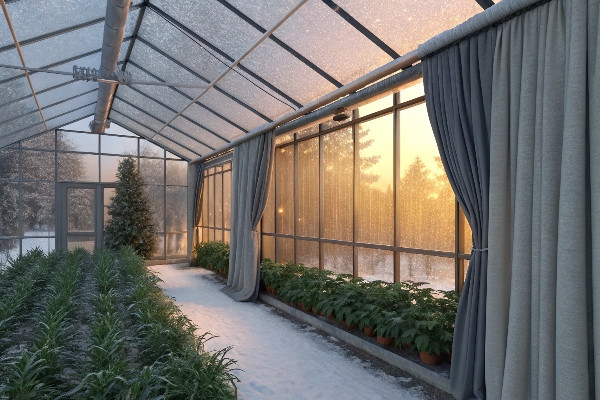
After 28 years in the greenhouse industry, I have seen countless growers struggle with winter heating costs. The secret lies not just in heating power, but in creating an integrated system that captures and retains heat efficiently. Let me share the comprehensive strategies that have helped our clients across 20+ countries achieve successful winter harvests.
Don’t Miss:——Commercial Hydroponic Greenhouse Systems: How Do Design, Construction, and ROI Interconnect?
You might like:——What is a Smart Greenhouse? The Ultimate Guide to Automated Growing
How Does Greenhouse Structure and Insulation Reduce Heat Loss?
Your greenhouse structure acts as the first defense against winter cold. Poor insulation wastes money. Smart design saves energy and protects crops effectively.
Proper greenhouse insulation reduces heat loss by up to 70% through strategic top and side barriers. Commercial greenhouses use double-layer systems with thermal curtains to maintain stable temperatures during harsh winter conditions.

The foundation of efficient winter greenhouse operation starts with understanding heat loss patterns. In cold regions, heating systems must work continuously to maintain growing temperatures. However, the greenhouse structure itself determines how much of that generated heat actually stays inside your growing space.
Our experience with commercial greenhouse projects has taught us that mainstream insulation systems fall into two main categories. Top insulation systems prevent rapid heat dissipation through the roof area, which typically accounts for the largest heat loss surface. Four-sided insulation systems protect against lateral heat transfer through walls and provide crucial nighttime temperature protection.
I remember working with a large tomato producer in Kazakhstan who was spending enormous amounts on heating costs. His greenhouse had basic single-layer covering with no insulation strategy. We implemented a comprehensive insulation upgrade that included thermal curtains on all sides and specialized top barriers. The results were dramatic – his heating costs dropped by 55% in the first winter season.
The key innovation we developed at CFGET involves adding external slopes to greenhouse structures. These slopes serve dual purposes that many growers overlook. First, they create wind resistance that prevents cold air infiltration around the structure base. Second, for film-type greenhouses, these slopes create an additional thermal barrier equivalent to double-layer covering systems.
Insulation System Components
| Component Type | Function | Energy Savings |
|---|---|---|
| Top Thermal Curtains | Prevent roof heat loss | 30-40% |
| Side Wall Insulation | Block lateral heat transfer | 20-25% |
| Foundation Barriers | Stop ground heat loss | 10-15% |
| External Slopes | Wind resistance + double insulation | 15-20% |
The thermal curtain technology we use operates automatically based on temperature sensors. During daylight hours when solar gain helps maintain temperatures, curtains retract to maximize light transmission. As evening temperatures drop, the system deploys curtains to create insulated air pockets that dramatically reduce heat loss rates.
What Heating Solutions Work for Different Greenhouse Sizes?
Different greenhouse sizes need different heating approaches. Small home greenhouses require simple solutions. Large commercial operations need sophisticated systems that balance cost and efficiency.
Greenhouse heating solutions range from electric heaters for small structures to central boiler systems for commercial operations. The optimal choice depends on greenhouse size, crop requirements, local fuel costs, and climate conditions.
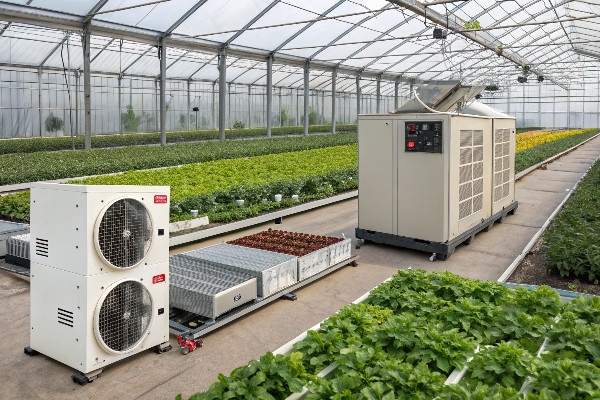
Selecting the right heating system requires understanding your specific operation scale and local conditions. Home greenhouse owners typically work with spaces under 1000 square feet and need straightforward, reliable heating that doesn’t require complex maintenance. Commercial growers manage thousands or tens of thousands of square feet and need systems that deliver consistent performance while minimizing operational costs.
For home and small hobby greenhouses, electric resistance heaters provide the simplest solution. These units offer precise temperature control and require minimal installation expertise. However, electricity costs can become significant in regions with high utility rates. I often recommend small greenhouse owners consider propane heaters as an alternative, especially in areas where natural gas connections aren’t available.
Medium-sized greenhouses serving local markets or specialty crops benefit from hot water heating systems. These systems use a central boiler to heat water that circulates through pipes or radiators throughout the greenhouse space. The thermal mass of water provides stable temperature distribution and reduces the cycling frequency compared to forced air systems.
Large commercial operations require the most sophisticated approach. Central heating plants using natural gas, biomass, or waste heat can serve multiple greenhouse structures simultaneously. These systems achieve the highest efficiency rates and lowest per-unit heating costs, but require significant upfront investment and professional maintenance programs.
One of our most successful commercial installations involved a 50-acre vegetable production facility in Netherlands. The grower needed reliable heating for year-round cucumber production while meeting strict sustainability requirements. We designed a combined heat and power system that uses natural gas to generate electricity while capturing waste heat for greenhouse heating. This approach reduced overall energy costs by 45% compared to separate heating and electrical systems.
The heating distribution method matters as much as the energy source. Forced air systems move heated air through ducts and fans, providing rapid temperature response but creating potential humidity issues. Radiant heating systems warm objects and soil directly, creating more even temperature distribution with less air movement that can stress plants.
Heating System Comparison
| System Type | Best For | Installation Cost | Operating Cost | Maintenance |
|---|---|---|---|---|
| Electric Resistance | Home greenhouses | Low | High | Minimal |
| Propane Heaters | Small commercial | Medium | Medium | Low |
| Hot Water Boilers | Medium operations | High | Low | Medium |
| Central Heat Plants | Large commercial | Very High | Very Low | High |
How Can Solar and Geothermal Energy Provide Sustainable Greenhouse Heating?
Sustainable heating reduces long-term costs and environmental impact. Solar and geothermal systems offer renewable alternatives. These technologies work especially well when integrated with traditional heating systems.
Solar and geothermal heating systems can provide 50-80% of greenhouse heating needs in suitable climates. These renewable technologies reduce operating costs and carbon footprint while ensuring reliable crop production throughout winter months.

Renewable energy integration represents the future of sustainable greenhouse production. Solar heating systems capture and store thermal energy during daylight hours for use during cooler periods. Geothermal systems tap into stable underground temperatures to provide consistent heating with minimal external energy input.
Solar thermal systems work by circulating water or air through collectors that capture solar radiation. The heated medium then transfers energy to the greenhouse space through radiators, heated floors, or forced air systems. Thermal mass storage using water tanks, rock beds, or phase-change materials allows solar systems to provide heating during cloudy periods and nighttime hours.
I worked with an organic herb producer in California who wanted to eliminate fossil fuel use completely. We designed a solar thermal system with 2000 square feet of collectors and a 5000-gallon insulated storage tank. During summer months, the system provides all heating needs while building up stored thermal energy. In winter, solar contributes about 70% of heating requirements with a backup electric system handling peak demand periods.
Geothermal systems offer more consistent performance than solar but require suitable geological conditions. Ground-source heat pumps extract thermal energy from stable underground temperatures through buried pipe loops. Even in cold climates, ground temperatures remain relatively constant year-round, typically 45-55°F at depths of 6-8 feet.
The efficiency advantage of geothermal systems1 comes from moving existing heat rather than generating new heat. A properly designed geothermal system can deliver 3-4 units of heat energy for every unit of electrical energy consumed. This efficiency ratio makes geothermal competitive with fossil fuel systems even in areas with moderate electricity costs.
Hybrid systems2 combining renewable and conventional heating provide the most reliable and cost-effective approach for most commercial operations. Solar or geothermal systems handle base heating loads while conventional backup systems ensure adequate capacity during extreme weather conditions. This approach maximizes renewable energy utilization while maintaining production security.
One of our most innovative installations combines all three approaches – solar thermal, geothermal, and high-efficiency natural gas backup. This system serves a 10-acre ornamental plant production facility in Colorado. The renewable systems provide 85% of annual heating energy while the backup system ensures reliable production during the most challenging winter conditions.
Renewable Heating Performance
| Technology | Energy Contribution | Payback Period | Climate Suitability |
|---|---|---|---|
| Solar Thermal | 40-70% | 8-12 years | High sun regions |
| Geothermal | 60-90% | 10-15 years | Most climates |
| Hybrid Systems | 70-85% | 6-10 years | All climates |
Why Do Smart Climate Control Systems Matter for Temperature Regulation?
Smart control systems optimize heating efficiency automatically. Manual temperature management wastes energy and risks crop damage. Automated systems respond faster and more precisely than human operators.
Smart greenhouse climate control systems reduce energy consumption by 25-40% through precise temperature and humidity regulation. These systems prevent crop stress while minimizing heating costs through automated optimization and predictive control algorithms.

Modern greenhouse climate control represents a revolutionary advancement in growing efficiency and crop quality. These systems integrate multiple sensors, automated equipment, and intelligent algorithms to maintain optimal growing conditions while minimizing energy consumption and labor requirements.
Temperature sensors throughout the greenhouse space provide real-time data on thermal conditions at plant level rather than relying on single-point measurements. Humidity sensors track moisture levels that affect both plant health and heating system efficiency. Outside weather stations provide predictive data that allows the system to anticipate heating needs before indoor conditions change.
The control algorithms use this sensor data to operate heating systems, ventilation fans, thermal curtains, and other equipment automatically. Instead of simple on-off cycling, advanced systems modulate heating output to maintain steady temperatures within narrow ranges. This precision prevents the temperature swings that stress plants and waste energy through overshooting target temperatures.
I recently completed an installation for a research facility growing medicinal plants where temperature precision was critical for active compound development. The smart control system maintains temperatures within ±1°F throughout the entire 5000 square foot facility. This precision level would be impossible to achieve through manual operation and ensures consistent product quality that commands premium prices.
Predictive control capabilities represent the most advanced feature of modern systems. Weather forecasting data allows the system to pre-heat during periods before cold fronts arrive. Solar radiation predictions help optimize thermal curtain operation to balance light transmission with heat retention. These predictive functions reduce peak heating loads and energy costs.
Integration with mobile devices and internet connectivity enables remote monitoring and control capabilities. Growers can receive alerts about system malfunctions, temperature excursions, or equipment failures regardless of their physical location. Historical data logging helps identify efficiency improvement opportunities and supports crop production optimization.
The economic benefits of smart climate control extend beyond energy savings. Automated systems reduce labor requirements for routine monitoring and adjustment tasks. More consistent environmental conditions improve crop yields and quality, leading to higher revenue per square foot. Reduced plant stress from environmental fluctuations decreases disease pressure and crop losses.
Our smart control systems include failsafe mechanisms that protect crops during equipment failures or power outages. Battery backup systems maintain critical functions during short power interruptions. Automatic alerts notify operators immediately when intervention is required. Redundant sensors ensure continued operation even if individual components fail.
Smart Control System Benefits
| Function | Energy Savings | Operational Benefit |
|---|---|---|
| Automated Temperature Control | 15-25% | Consistent growing conditions |
| Predictive Heating | 10-15% | Reduced peak demand |
| Thermal Curtain Optimization | 20-30% | Balanced light and insulation |
| Remote Monitoring | 5-10% | Reduced labor requirements |
Conclusion
Successful winter greenhouse heating combines proper insulation, appropriate heating systems, renewable energy integration, and smart controls for optimal crop production and energy efficiency.

